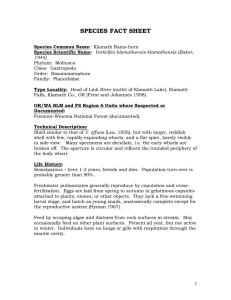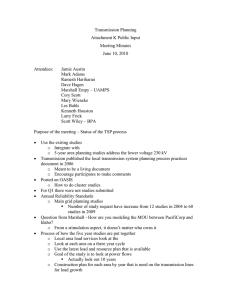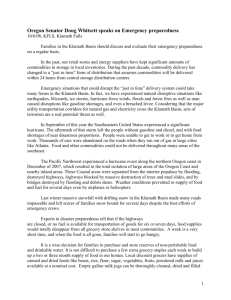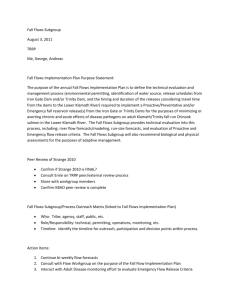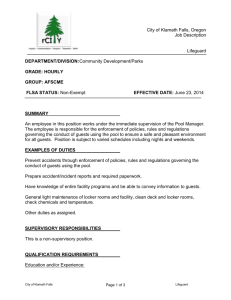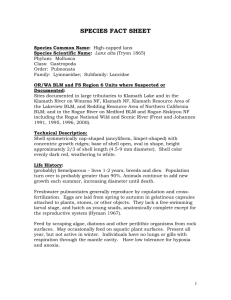Reuniting a River
advertisement
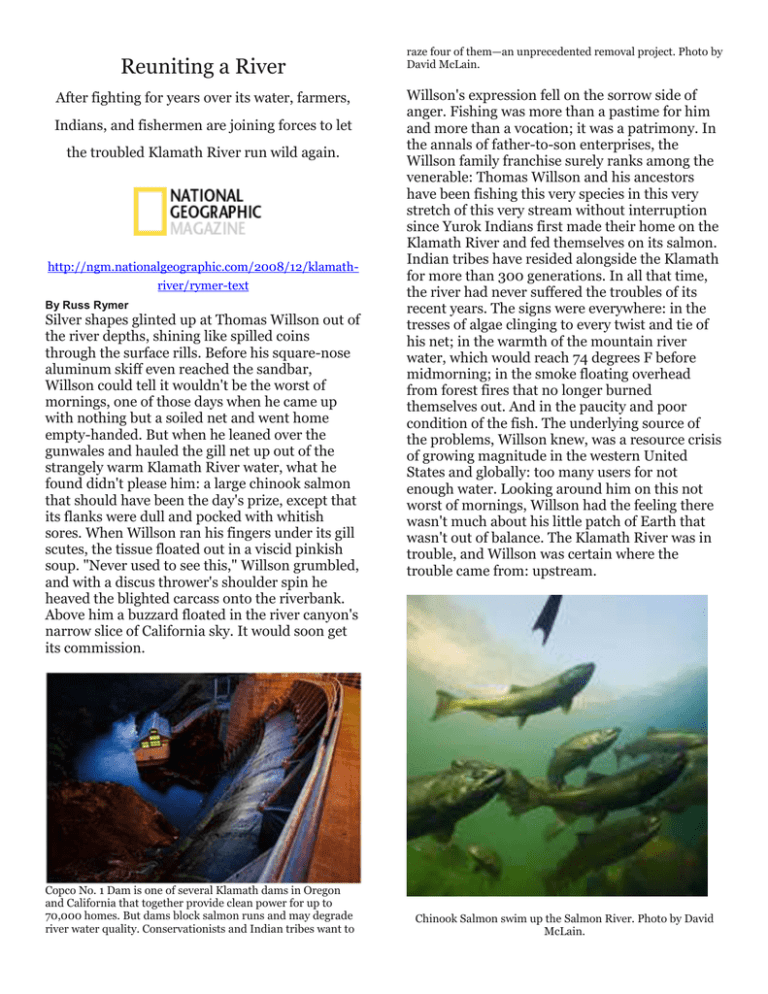
Reuniting a River After fighting for years over its water, farmers, Indians, and fishermen are joining forces to let the troubled Klamath River run wild again. http://ngm.nationalgeographic.com/2008/12/klamathriver/rymer-text By Russ Rymer Silver shapes glinted up at Thomas Willson out of the river depths, shining like spilled coins through the surface rills. Before his square-nose aluminum skiff even reached the sandbar, Willson could tell it wouldn't be the worst of mornings, one of those days when he came up with nothing but a soiled net and went home empty-handed. But when he leaned over the gunwales and hauled the gill net up out of the strangely warm Klamath River water, what he found didn't please him: a large chinook salmon that should have been the day's prize, except that its flanks were dull and pocked with whitish sores. When Willson ran his fingers under its gill scutes, the tissue floated out in a viscid pinkish soup. "Never used to see this," Willson grumbled, and with a discus thrower's shoulder spin he heaved the blighted carcass onto the riverbank. Above him a buzzard floated in the river canyon's narrow slice of California sky. It would soon get its commission. Copco No. 1 Dam is one of several Klamath dams in Oregon and California that together provide clean power for up to 70,000 homes. But dams block salmon runs and may degrade river water quality. Conservationists and Indian tribes want to raze four of them—an unprecedented removal project. Photo by David McLain. Willson's expression fell on the sorrow side of anger. Fishing was more than a pastime for him and more than a vocation; it was a patrimony. In the annals of father-to-son enterprises, the Willson family franchise surely ranks among the venerable: Thomas Willson and his ancestors have been fishing this very species in this very stretch of this very stream without interruption since Yurok Indians first made their home on the Klamath River and fed themselves on its salmon. Indian tribes have resided alongside the Klamath for more than 300 generations. In all that time, the river had never suffered the troubles of its recent years. The signs were everywhere: in the tresses of algae clinging to every twist and tie of his net; in the warmth of the mountain river water, which would reach 74 degrees F before midmorning; in the smoke floating overhead from forest fires that no longer burned themselves out. And in the paucity and poor condition of the fish. The underlying source of the problems, Willson knew, was a resource crisis of growing magnitude in the western United States and globally: too many users for not enough water. Looking around him on this not worst of mornings, Willson had the feeling there wasn't much about his little patch of Earth that wasn't out of balance. The Klamath River was in trouble, and Willson was certain where the trouble came from: upstream. Chinook Salmon swim up the Salmon River. Photo by David McLain. Two hundred and fifty miles upstream, at two in the morning, the alarm blared on the humidity meter on the Formica snack table in Steve Kandra's RV, and Kandra slid out of his berth and into his boots and climbed aboard the John Deere tractor awaiting him in his pitch-dark alfalfa field, a field irrigated by the same Klamath waters that Thomas Willson fishes. Kandra had mowed the alfalfa several days before; tonight he would bale it while the cut crop was safe from the parching daytime heat and before the morning dew turned everything too wet. Farming by ideal conditions meant living on the wrong side of adage: Kandra makes hay till the sun shines. As drought years have become more problematic in the Klamath region, the competing water needs for Thomas Willson's fish and for Steve Kandra's fields have aggravated the rivalry between the Indian tribes living near the northern California coast and the irrigating farmers upstream along Oregon's arid southern border. The trouble, as farmers see it, came to a boiling point in 1997. That's the year coho salmon were accorded federal protection under the Endangered Species Act, which would entitle them to minimum flows of water. In 2001 tensions came to a dramatic head when the federal government shut off irrigation water to some 1,400 Klamath Reclamation Project farmers, including Kandra. The families felt singled out—"Farmers aren't used to being vilified," Kandra notes—and some responded with civil disobedience. They partially opened the irrigation canals' headgates in defiance of federal marshals and queued up for a symbolic bucket brigade through the streets of Klamath Falls, Oregon. That summer the upper basin was a dry Dust Bowl flashback to The Grapes of Wrath. But by the following spring, reportedly thanks to Vice President Dick Cheney's behind-the-scenes intervention, the situation had reversed. In March 2002, Agriculture Secretary Ann Veneman and Secretary of the Interior Gale Norton flew to Klamath Falls to open the valve into the main diversion canal and assure farmers they would have the water they needed. Matter settled. Then came the sequel. As Thomas Willson recounts, in September 2002, a vanguard of the fall salmon migration passed the coastal sandbar at Requa, California, and entered the mouth of the Klamath. The fish swam as far upstream as Blue Creek, a popular deeppool gathering ground for their run up the river. Then, perhaps because the water in the slack river was so warm, they retreated back to the estuary. Rain in the Siskiyou Mountains cooled the river enough to encourage the fish to head back upstream, but when the weather turned sunny and hot, the fish, wearied by the false start and weakened by infections, didn't get far: At least 30,000 chinook salmon died in the lower 40 miles. Their carcasses carpeted the Klamath's banks in one of the largest adult fish die-offs in U.S. history. Year 1978 1979 1980 1981 1982 1983 # Chinook (1000s) 90 50 45 80 70 60 1984 1985 1986 1987 1988 1989 45 65 190 210 185 125 1990 1991 1992 1993 1994 1995 1996 1997 1998 1999 30 25 20 60 55 225 175 80 85 50 2000 2001 2002 2003 2004 2005 2006 2007 220 185 135 190 75 60 55 130 Event Ocean Fisheries Restricted New salmon conservation objectives and a native fisheries sharing agreement go into effect California coastal Chinook listed as threatened Fishing constraints 30,500 Fish die off from disease The root causes of the massive fish kill remain disputed—there had been warmer temperatures and lower water levels, without disaster—but it certainly seemed to fulfill the dire prophesy of those who had opposed the opening of the floodgates and the constriction of river flows. Indian tribes and farmers and commercial ocean fishermen (who can have their seasons curtailed when salmon are scarce) confronted each other over flow rates and toxic algae, environmentalists insisted that farmers be evicted from leased land on Klamath wildlife refuges, and almost everyone squared off against Pacific Power, the company that owned the hydroelectric dams controlling the flow of the water. An epic American free-forall erupted. Behind the Klamath's oldest dam, a biologist samples soupy water thickened by cyanobacteria in the Copco Lake. The toxic microorganism blooms when water heats up in summer. Photo by David McLain. In the annals of father-to-son enterprises, the three-generation Kandra franchise may not boast the longevity of Willson & Co., but it can still be expressed in epic terms: Kandras have cultivated Klamath land ever since it became land. The two stretches of open field and farmyard homesteaded by Steve Kandra's grandfather and father look as solid as slab granite, but they bear liquid names: Lower Klamath Lake to the west, and Tule Lake to the east. A little over a century ago, they were just that: expansive lakes. Beginning in the early 1900s, in a mammoth engineering endeavor christened the Klamath Reclamation Project, much of the lake water was drained by the U.S. Reclamation Service to create new farms, more than 100,000 acres of them, and the new land was irrigated to make it arable. Hundreds of miles of canals and tunnels were built, and massive pumps installed to sluice water in and out. The "reclaimed" land in Tule Lake Basin was homesteaded, much of it by returning veterans of both World Wars whose names were drawn from a pickle jar; the farmers planted alfalfa, grain, potatoes, and onions on some of the most fertile soil in the West. Fertile because, as Kandra noted, shouting over the roar of his baler as he traced windrows of alfalfa in the headlights of his John Deere, "down below us is a thousand feet of goose poop. It's old lake bottom. We're farming the top of a custard—you know how custard has a skin on it? We're on top of the skin." The partition of the Klamath River was made concrete in 1918, when the California Oregon Power Co. (long known as Copco; later bought by Pacific Power) built the first of its big hydroelectric dams on the Klamath. Three other major dams followed, the farthest downstream being Iron Gate Dam, finished in 1962. Today the dams are the backbone of the power system that produces 750,000 megawatt hours for Pacific Power in an average year, enough to meet the electricity needs of 70,000 homes. It's especially useful power in that it releases no carbon emissions and can be turned on in an instant to supply peak needs. The dams have long been a focus of local pride for the upriver communities, emblems of autonomy for a region that had always held itself self-consciously apart. Residents call this stretch of far northern California and far southern Oregon the "State of Jefferson," and have on occasion discussed separating from their respective states and incorporating as a new state. Various efforts at statehood have faltered over the years, but Jefferson lives on as a code name for pugnacious patriotism. From the start, the local utility was a part of this independence. "I've heard that when they held an essay contest for the name of the new state they were going to form, the name that was suggested second to 'Jefferson' was 'Copcoland,' " says Toby Freeman, regional community manager with Pacific Power. Whatever their utilitarian purpose, the dams effectively divided the river into two peoples, one of which lived off salmon, and the other of which never even saw one, since the dams obstructed the fish's upstream migrations. For the dams' opponents, the physical obstacle is only one of the ways the dams upset the Klamath's balance. Fishermen contend that the water impoundment alters the temperature and flow of river waters, encouraging fish diseases. In 2008, the Karuk Tribe released a report concluding that the cyanobacteria, commonly called blue-green algae, that bloom dramatically in the still summer waters behind Iron Gate are releasing toxins that could make fish and freshwater mussels unsafe to eat. The issues in play over the Klamath's future are complex, but one prospect resides at the center of all the debate: removing the four hydroelectric dams. Advocates hope this might restore the river to its natural condition and allow migrating salmon an unobstructed path to headwater breeding grounds for the first time in a century. Demolition of the dams would also remove a symbolic barrier between the upriver and downriver human communities, but those parties haven't waited for dynamite to facilitate their convergence. For the past eight years, a group of affected parties—governmental, tribal, industrial, and private—has been convening over an endless series of conference tables in drab offices and motel meeting rooms, working its way through a cat's cradle of interlocking questions. If the talks succeed in resolving the Klamath conflict, the result will be historic. And if the dams are removed, notes Craig Tucker, Klamath Campaign coordinator for the Karuk Tribe, "this will be the largest dam removal ever on an American river. This can be a model for environmental cooperation." Just in time, some might say. The perils to the nation's rivers are growing dramatically, as population growth and rising water usage overtax watersheds and deplete aquifers. In the western United States, that skyrocketing demand is on a crash course with the alarming effects of climate change. In response to warming temperatures, winters are bringing less and less snow to the American West, and snowpack is mother's milk to rivers like the Klamath. The Cascades and other Northwest mountains whose snowmelt feeds the river are the harbingers of what's to come elsewhere. Since the 1940s they have seen a significant decline in total snow accumulation because they are lower in elevation and so more susceptible to the region's rising temperatures than other western mountains. All of which makes the decisions over how to handle the competing needs for the Klamath's waters even more crucial. In coming decades, as governmental agencies turn increased attention to rescuing the world's riverine ecologies, they may cast an eye back to the way the small and relatively isolated communities of the Klamath River watershed negotiated their entrenched local issues and resolved historic antagonisms. Especially since until this year, those issues seemed so intractable, and the antagonisms so fierce. Toby Freeman of Pacific Power, the company that would be responsible for the dams' removal, understands those antagonisms as well as anyone. Last year, asked for his forecast on the outcome of the river negotiations, he responded with bureaucratic cheer. "In the long run, I'm looking forward to a resolution that fully addresses the river's health while providing the best outcome for our customers," he said. "In the short run," he added, "I'll be happy if no one gets shot." Perhaps it's appropriate that the sources of the Klamath River begin in a geographic region known informally as the "blast zone." The blast in question was the eruption 7,700 years ago of Mount Mazama, one of the restive volcanic cones of the High Cascades, in southernmost Oregon. Klamath Indians explained the explosion as a battle between the sky god Skell and Llao, the deity of the underworld. Crater Lake's 1,943-foot depths were created following volcanic eruptions 7,700 years ago; a lava outcrop juts from the northwest rim of the caldera. Snowmelt from the surrounding Cascade Mountains percolates through the land to the south, emerging as springs that feed streams flowing into Upper Klamath Lake. Photo by David McLain. Geologists describe it more technically. A series of eruptions blew much of Mazama's molten understory skyward; a mile-wide column of pumice, ash, and gas climbed into the upper stratosphere. As the 12 cubic miles of mountain and mantle fell back earthward, it draped 320 million acres in tephra—volcanic ash and rock— in a layer as thick as 20 feet. The remaining bulk of Mazama's summit collapsed (the mountain lost about a mile of elevation during the eruption), and the caldera filled partially with water, creating the consummate natural tourist attraction, Crater Lake. To the lee of the crater stretched a vast new living desert of pumice, and, with time, a broad-based forest ecosystem dominated by bitterbrush, aspen, and lodgepole pine. Crater Lake locals liken a stroll through the blast zone to walking in kitty litter. The pale granular topsoil crunches underfoot and emits effusions of smoke-fine dust. Coursing through the kitty-litter landscape are the tannin-stained streams that make up the headwaters of the Klamath River. They are fed by snowmelt from the Cascades, but much of that melt doesn't run downhill as surface water. Instead it soaks deep into the absorbent tephra and bubbles up as springs to feed the Williamson and Sprague Rivers, which run into Upper Klamath Lake. The water flows from there into Lake Ewauna, the official beginning of the Klamath River, which then flows into the Cascades and along the rugged Siskiyous. Its progress looks decidedly odd to anyone who's ever seen a … well, to anyone who's seen a river. "It's a river upside down," Steve Pedery explained one summer afternoon, echoing a phrase often used to describe the Klamath. Pedery was speaking over the propeller roar of a Cessna. He is conservation director of Oregon Wild, an environmental organization, and the plane was courtesy of LightHawk, a group that provides overflights of ecological battlegrounds. "You know," Pedery said, as the lakes below us dwindled into a thin tinsel ribbon, "most rivers begin in the mountains, flow into farmland, and end up in a heavily industrialized urban port. The Klamath starts in farmland and flows through mountains that become wilder the closer you get to the coast." The river is upended in another way. Most rivers begin pristine and wind up filthy. The Klamath gets "dirty" at its outset and becomes cleaner as it goes along. Even without the significant agricultural pollution feeding the profuse bluegreen algae that skews the ecology on the upper Klamath, the river would have high levels of nutrients such as phosphorus, derived from the lake-bed soils of Upper Klamath Lake. Similarly, the warmth of the water may be exacerbated by dam impoundment and basking in farmers' fields, but the river was always naturally warmed by wide shallow lakes at its source. Only as the Klamath is joined along its descent by more traditional tributaries, the Trinity and the Scott and the Salmon, does it clean up and, at least temporarily, cool down. Seasonal workers sort the 50,000 pounds of onions thirdgeneration farmer Scott Seus grows on each of 500 acres. "My land doesn't just support my family," he says. At peak times, "it's the livelihood of a hundred people." Photo by David McLain. The Klamath's upside-down design means it is exceptionally well poised to benefit from restoration. It has little of the industry and suburban development that clutter the shores of most American rivers. Most of its last 40 miles can only be visited by boat; no through road follows the river's course, and remote tribal villages like Pecwan, where Thomas Willson launches his fishing boat, are beyond the reach of electricity. If the dams are remade or removed, many experts agree that the Klamath could bounce back and become perhaps the healthiest big salmon river in the West. Maybe just as remarkable, saving the river could put an end to an unlovely slugfest among parties that historically, at least in the case of farmers (read pioneers) and Indians (read Indians), had been drawing each other's blood for a century and a half. The Indians of the Klamath River watershed were among the very last Native Americans to be overrun by Manifest Destiny. A handful of tribes called the region home: the Modoc, Klamath, and Shasta Indians in the upper and middle basin, and the Karuk, Hoopa, and Yurok in the lower. The human onslaught that overtook them began in the mid-1800s; it would bring successive waves of settlers, gold miners, soldiers, loggers, farmers, and commercial fish canners. When the extraction of gold in the river's tributaries sent slurries of mud and tailings downstream, the native peoples got their first exposure to industrial pollution, and to the notion that an economy could be enriched by destroying its resources, instead of husbanding them. The Klamath River tribes were traders, and their currency, dentalium shells that tribespeople carried in oblong elk-horn purses, was valuable in relation to its scarcity. The shells were acquired from other tribes far to the north; unlike gold, they required no desecration to accumulate. One hundred years after the gold rush, the lower Klamath welcomed an unusual visitor: Erik Erikson, the psychoanalyst who popularized the notion of the identity crisis. He'd come to study the Yurok Indian Tribe, whose worldview he described as "centripetal." Erikson meant that Yurok society was inwardly focused, a closed bell jar of a universe into which salmon and deer entered to sustain the tribe, but which the tribe's members never left. Their compass points were "away from the river" and "toward the river," as though the Klamath exerted an irresistible magnetic force that attracted much but let little go. The lower Klamath tribes share a religion known as World Renewal, which exalts nature's interconnectedness but sees that balance as precarious. Hillman was inducted into the Karuk priesthood and underwent a week of fasting and purification, sleeping by the fire in the sweat lodge and setting out each morning, dressed in deerskin and painted by an elder priest, on quests into the wild, learning the scripture of humanity's relationship with nature. Humans have a responsibility to all other elements of nature, Hillman told me. "It's a reciprocal arrangement. We understand, and we know, that we owe our existence to the river." The river was transportation and it was also sustenance, providing the willows used to make baskets and bringing the salmon and lamprey and trout that complemented acorns in the native diet. Back then, as the elders remember it, the fish were so thick that a person "could walk across the river on their backs," and salmon filled every belly. Traditionally, Karuk Tribe members each ate more than a pound of salmon a day, an intake that has dwindled in recent decades to under five pounds a year, with a commensurate surge in diabetes and heart disease. With the disruption of the Indians' livelihood, and the river's inhabitants divided into mutually antagonistic communities, the Klamath faced the conundrum that stymies environmental efforts everywhere: Its problems were vast and expanding, but the communities that might solve them were too fragmented to mount a holistic response. Ironically, the historic bone of contention, the old Copco dams and what should happen to them, became the agent that would bring the warring parties together. A late-summer moon rises over a Karuk war dance. "The dance is a ceremony that seeks solutions between families, individuals, and villages," says Ron Reed, cultural biologist of the Karuk Tribe. The Karuk advocate removing four of the Klamath River's hydroelectric dams. According to Reed, this dance was intended to support resolution of ongoing disputes in the Klamath River watershed. Photo by David McLain. Leaf Hillman is vice chairman of the Karuk Tribe and a World Renewal priest whose family oversees a White Deer Dance, one of the rituals through which cosmic equilibrium is maintained. "This is a pretty unique place in the world," Hillman told me one day, kneeling by the entrance of a traditional sweathouse, a ten-footby-ten-foot-square structure topped with a gabled, wood-plank roof. The Klamath's currents burbled only yards away. When he was 13, Four years after the massive salmon kill of 2002, the licenses for all four mid-Klamath dams came up for their 50-year renewal by the Federal Energy Regulatory Commission. In anticipation, Pacificorp, the parent company of Pacific Power, had begun meetings in 2000 with the Klamath area tribes, municipal governments, commercial fishermen, farmers, and environmental groups. The issues were daunting: What could replace the dams in providing Siskiyou County's tax base? If the dam removal succeeded in restoring salmon to the upper Klamath, what would happen if a farmer found an endangered coho in his irrigation canal; would he be shut down under the Endangered Species Act? Oregon Wild pushed hard to have farmers evicted from leased land on wildlife refuges; the Hoopa Valley Indian Tribe insisted that scientific studies be commissioned to verify that water-flow allotments would support the salmon. In 2006, after years of debate, and with talks expanding beyond dam removal and into such issues as tribal rights and river restoration, the group disbanded. Karuk, Hoopa, and Yurok Tribe members demonstrate for dam removal during a cocktail reception at Berkshire Hathaway's May 2008 shareholder meeting in Omaha, Nebraska. The multibillion-dollar conglomerate is the parent company of PacifiCorp, which operates the Klamath dams. Photo by David McLain. And then it reconvened, without Pacific Power involved, and with some of the more intransigent parties disinvited. Ron Cole, refuge manager for the Klamath Basin National Wildlife Refuges and, like Craig Tucker and Steve Kandra, a party to the talks, observed the turnaround. "The folks in this basin have never missed an opportunity to miss an opportunity, but I think they're tired of it," he told me. "This is considered ground zero for screwing up. But it can also be ground zero for success." A Native American boy hugs two Chinook salmon near the river. Photo by David McLain. Last January the settlement parties announced the Klamath Basin Restoration Agreement, outlining options for saving the river. But negotiations with PacifiCorp over removal of the dams—a key part of the plan—continue to drag on. Some entities, including the Hoopa tribe, remain unconvinced that their concerns have been addressed. And congressional action will be necessary to defray economic damages— implementing the agreement would cost hundreds of millions, perhaps billions, of dollars. Still, the most promising indication for success, and for the future of the Klamath, may have already taken place: the transformations within the individual river communities. The farmers took to heart their own observation of the Klamath's failing ecology. "People see that our farm inputs—oil, water, fertilizer—aren't infinite, like they seemed to be 20 years ago," Klamath farmer John Anderson said. The Andersons responded by shifting crops and refining their irrigation methods. Other farmers, like the Kandras, installed new pivot irrigators that are stingier with water than the old, crude fieldflooding methods. In the Tule Lake Basin, farmers have also been rotating their fallow fields into lake and marsh as part of a U.S. Fish and Wildlife program called Walking Wetlands. The rotation is heralded as good for wildlife and for agriculture: It provides bulrush sanctuary to migratory birds while replenishing the land so that it is more productive when it again goes under cultivation. Even such mutually beneficial arrangements required a laying down of old suspicions, noted Ron Cole, as he marched with wildlife biologist Dave Mauser through a soon-to-be-flooded field, wearing his Department of the Interior greens. "Years ago, there's no way we would be standing in these uniforms in this private field," he marveled. For their part, the lower Klamath Indians have had to break out of a tradition of secretiveness— born of the time when they fished and worshipped only at night and spent their days hiding in caves, trying to stay invisible. Now they must join in a boisterous debate with people they've never been able to trust. "In my mind that's the very thing that saved us, our ability to blend in. But now that strategy has to change," Leaf Hillman explained, "because if we continue to blend in and not be noticed, that will spell our doom." Meanwhile, the farmers upstream are sounding like nothing so much as World Renewal converts, proselytizing the community of all nature. "As a man of faith," Steve Kandra said, "I think the water crisis was God saying you guys gotta figure it out, because you're related to each other. You guys better figure it out. Well, us folks that are here on the ground, we're working darn hard to save these communities. I don't think anyone is going to accept elimination of one community over the other." "What I think has evolved is that people are looking out for the other guy's back, not just their own anymore," Ron Cole observed. "Just a little. The families up here, they never felt connected with this river. Now they do. They feel they're river people too." Klamath River Town Hall Meeting-River Management We are going to hold a town hall style public comment meeting on how to manage the Klamath River. Here are the roles: 1. Modoc, Klamath, Shasta, Yurok, Hoopa, and Karuk Indian Tribes-Your lifestyle has changed tremendously over the past 10 generations. One of the last cultural practices-fishing for salmon, is in danger. 2. Klamath Basin Farmers Association-Your lifestyle depends on water from the river both for electricity and irrigation. 3. Pacific Power-Your business is damming the river to create carbon free electricity. 4. Klamath Ecologists-You are a group of scientists dedicated to educating the public about the science that should drive decisions. 5. Oregon Wild-You are representing a real environmental group whose mission is to work to protect and restore Oregon’s wildlands, wildlife and waters as an enduring legacy for all Oregonians (and Californians). 6. US Department of the Interior Officials-You are representing the US Government and therefore several organizations involved with the river: Bureau of Indian Affairs, National Park Service, and Bureau of Reclamation. You will decide on what management plan to implement. Your task: 1. Read the article. 2. Form a group and choose a role. 3. Research the group and the issue. 4. Formulate your position and develop your argument. 5. Some possible positions: remove all/some dams, evict farmers, develop more farmland, develop the area, create more wilderness areas, do nothing, or reach a compromise. Your plan must be specific: What is minimum flow? How many salmon do you want to return annually? How many acres of farmland will you limit/expand? How much water do farmers get? How many dams do you want? Where do you want what you want. 6. Cite evidence, cite data, and cite your sources. Make sure to include at least five sources. 7. Important things to consider: the endangered species act; ecology of the river; Klamath farmers irrigation and pesticide techniques, cultural differences, economic interest, ecological interests, history of the region, geography, etc. Grading 1. Research-Does your position reflect extensive research and some aspect of knowledge of environmental science? 10 points 2. Speech-Does your presentation at the town hall represent your groups interest, show professionalism, and include logical counterpoints? 10 points 3. Teamwork-Does your presentation incorporate contributions from all members and did you use your time effectively? 10 points.
